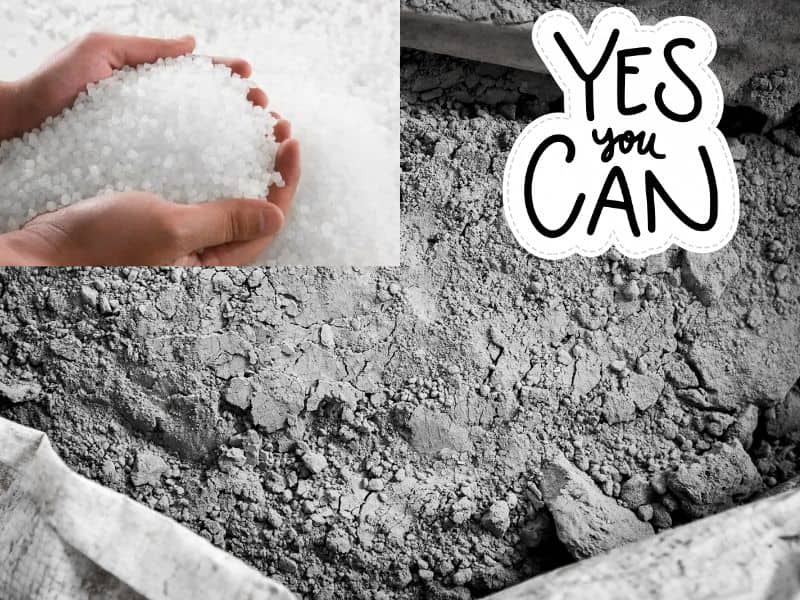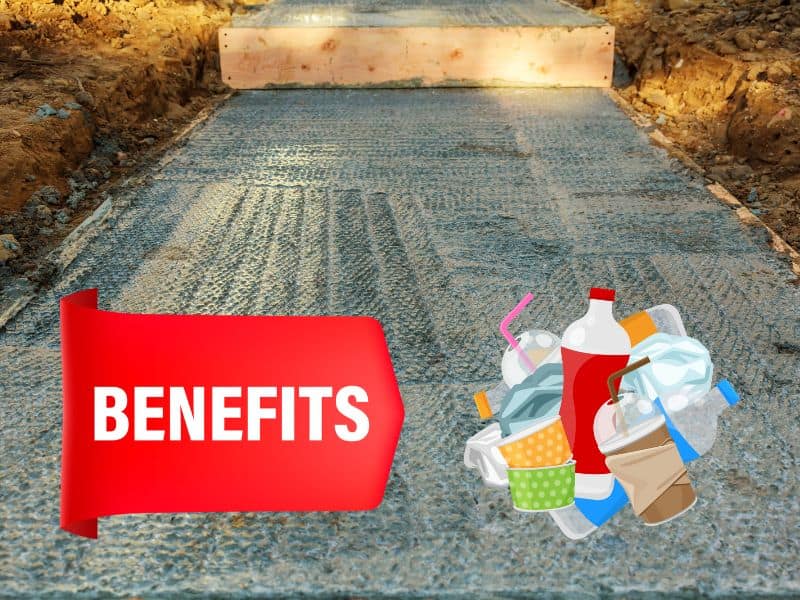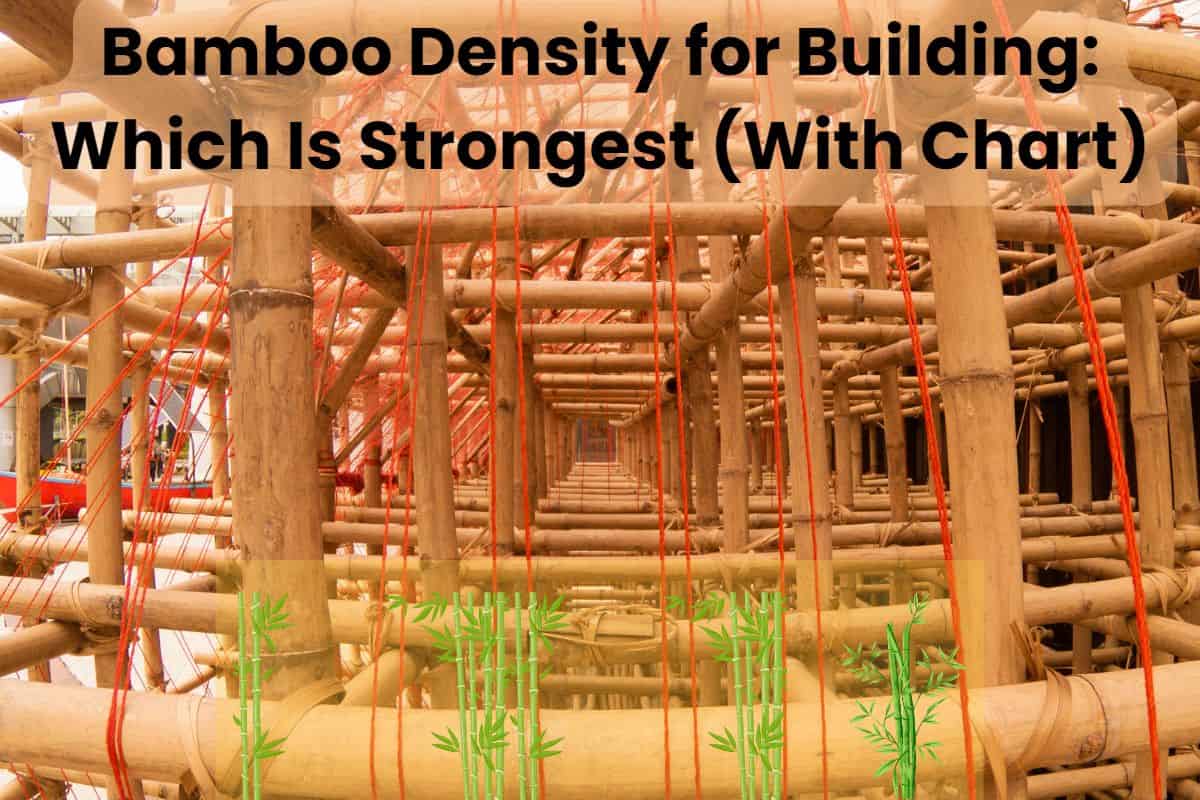Recycled Plastic and Concrete for Building: A Perfect Match?

We have a big environmental problem – too much plastic waste and inadequate systems for sustainably dealing with it all.
However, with global building trends moving away from traditional materials like concrete and wood, the pressure is on to find alternative green building solutions that are more sustainable and don’t deplete natural resources.
One promising answer could lie in looking at something we already have plenty of — waste — and mixing recycled plastic and concrete for building.
Could these two unlikely contenders be a winning combination for sustainable construction?
In the rest of this article, we investigate what comes from mixing recycled plastic and concrete for use by the building industry.
We’ll also discuss the benefits of mixing recycled plastic with concrete and evaluate how it contributes to a greener building industry.
Let’s get started!
Recycled Plastic and Concrete for Construction

The abundance of plastic waste helps to make it a viable option for replacing traditional building materials like concrete and wood.
However, what happens when recycled plastic is incorporated into concrete? Is it a perfect match?
Incorporating recycled plastic into concrete is a perfect match that results in a stronger bond and excellent flexural strength.
Studies have found that recycled plastic fortifies concrete, making it less prone to developing cracks. This is because the plastic particles in the concrete act as an additional binder that creates a more durable and flexible material.
Undergraduate students from the Massachusetts Institute of Technology (MIT) conducted a study to investigate the effect of irradiated and pulverized plastic flakes on concrete.
After mixing the two, the result was concrete that was 15 percent stronger than conventional concrete.
Moreover, according to Science Direct, macro plastic fiber (MPF) is used in the construction industry to enhance the performance of concrete. In this case, the plastic fiber acts as reinforcement in concrete.
MPF also helps reduce shrinkage and cracking in concrete, making it ideal for building durable structures.
Does Plastic Make Concrete Stronger?
Plastic strengthens concrete by providing additional binder that helps reduce cracking and shrinkage. Moreover, irradiated plastic blocks pores within the concrete, making it denser and stronger.
However, the plastic type determines the resulting concrete’s strength since plastics have different compressive strengths.
For instance, polyamideimide (PAI) has the highest tensile and compressive strength of 21,000 psi and 32,000 psi, respectively. Therefore, using this plastic in concrete would yield a stronger product.
Can You Mix Plastic With Cement?

Although you can mix plastic with cement, care must be taken to maintain the mix of sand, aggregate, and cement. A rule of thumb is to add no more than 4 percent of shredded plastic per unit of cement.
Also, for the best results, you should use plastic that has already been irradiated or pulverized into small pieces. This will help ensure it’s thoroughly mixed with the cement and other components in the concrete mixture.
It’s also important to note that mixing plastic with cement may increase its strength but also changes the material’s properties.
For instance, the cement will become less malleable than ordinary concrete. Therefore, you should adjust the plastic and cement ratio accordingly to achieve the desired results.
Can Plastic Replace Sand in Concrete?
You can replace up to 10 percent of sand in concrete with plastic for excellent strength and longevity. Unlike sand, plastic doesn’t stick to cement particles in the slurry to form a tight bond. Therefore, replacing the entire sand in concrete with plastic would reduce its strength significantly.
Using plastic in concrete saves sand and helps conserve the environment. By reducing the amount of sand used in construction, we can help protect beach environments, rivers, and streams.
Can Plastic Bricks Be Stronger Than Concrete?

Making bricks from sand and plastic results in a product stronger than concrete because plastic is fibrous. The fibrous nature of plastics enhances the compression strength of plastic bricks, making them stronger than their concrete counterparts.
According to Nzambi Matee, the founder of Gjenge Makers, their recycled plastic bricks are two to seven times stronger than concrete. Also, the bricks are affordable and less prone to cracking than regular concrete blocks.
It’s worth noting that although plastic bricks are stronger than concrete, their production is labor-intensive and requires specialized machines like extruders. Consequently, their production cost is higher than regular concrete blocks, making them more expensive.
How Sustainable Is Using Recycled Plastic Fiber in Concrete?
Using recycled plastic fiber in concrete is sustainable because it uses less water and fuel while emitting less carbon dioxide than virgin plastic fiber.
When used in concrete, recycled plastic fiber uses 78% and 28% less fuel and water, respectively, and emits 50% less carbon dioxide than virgin plastic fiber.
Replacing steel reinforcing mesh (SRM) with recycled plastic PP fibers also helps reduce the amount of waste generated. The fibers are lightweight and easy to install, reducing the need for labor-intensive installation processes.
Coupled with their ease of manufacturing compared to SRM, recycled plastic fiber makes an excellent aggregate for sustainable and strong concrete.
Benefits of Mixing Recycled Plastic With Concrete

The following are the main benefits of incorporating recycled plastic into concrete:
- Improved compressive strength: Since recycled plastic has excellent compressive strength, using it in concrete improves the overall strength of the mixture. Therefore, a mixture of recycled plastic with concrete is stronger and more durable.
- Enhanced water resistance and reduced permeability: The impervious nature of plastic helps reduce water permeability. Therefore, when mixed with concrete, the resulting mixture has lower hydraulic conductivity making it more water-resistant and suitable for areas prone to flooding.
- Sand conservation: By replacing sand with recycled plastic, you can conserve sand and help protect beach environments, rivers, and streams from soil erosion.
- Reduced carbon footprint: Using recycled plastic in concrete reduces the overall carbon footprint of the end product by minimizing fuel consumption and the use of other resources.
- Enhanced waste management: More than 11 million metric tons of plastic enter oceans annually, while much of the rest goes to landfill. Recycling and using these plastics in construction can help reduce plastic waste and preserve our environment.
Final Thoughts On Recycled Plastic and Concrete for Building
Using recycled plastic as a concrete additive results in an extremely sturdy construction material.
The fibrous nature of plastic enhances compression strength, making the resulting mixture stronger and more durable.
Moreover, using recycled plastic plays an essential role in sustainable construction by conserving sand and reducing fuel consumption, water use, and carbon dioxide emissions.
Overall, combining recycled plastic and concrete for building is a cost-effective and excellent way to reduce plastic waste.
Before you leave, check out these 7 components of green building to foster environmental protection.







